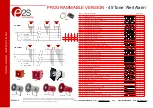
Note:
The 166XL’s expansion ratio is internally fixed, at approximately 10:1. This ratio helps to eliminate the artifacts normally associated with common
switch gates. Attenuation is >50dB.
SIDECHAIN (SC) ENABLE Switch and LED
:
This switch enables the 1/4” TRS connector of the sidechain, allowing external processing of the detector signal. It
has no effect if there is nothing plugged into the sidechain loop; however the switch will still light indicating the
sidechain is enabled.
Expander/Gate RELEASE Control:
This control determines the rate at which the gate closes once the signal at the INPUT or SIDECHAIN INSERT falls
below the threshold. SLOW settings are useful for gating out noise present behind vocals and acoustic instruments.
FAST settings are useful for tightening up the sound of percussion (e.g., kick or snare drum) and drying up leakage from
other instruments into percussion tracks.
Note:
The gate release rate is “accelerating” in that the dB/Sec rate continually increases as the gate closes.
CONTOUR Button and LED:
Depress this button to make the 166XL’s detection circuitry less sensitive to low frequency energy, preventing this
energy from “punching holes” in the sound, especially with mixed program. With the CONTOUR button Out, the
166XL’s detector is frequency-independent. The CONTOUR LED turns On when the CONTOUR button is depressed.
COMPRESSOR Section
GAIN REDUCTION Meter:
This meter displays how much the signal is being attenuated by the compressor and the gate.
Compressor THRESHOLD LEDs:
These three LEDs indicate the relationship of the input signal level to the threshold of compression. The green
BELOW LED is On when the signal is below threshold and the red ABOVE LED is On when the signal is above
threshold. When the 166XL is switched to OverEasy mode, the yellow LED is On when the signal is in the OverEasy
region (See Figure 2).
Note
: Even though no input signal is being applied, it is normal for the LEDs to flicker when the power is applied or removed.
Compressor THRESHOLD Control:
Adjust this knob to set the threshold of compression from -40dBu (7.8mVrms) to +20dBu (7.8Vrms). Setting the
Compressor THRESHOLD control to +20dB will prevent all but the highest level peaks from being compressed.
(Setting the Compressor RATIO to 1:1 will turn the Compressor off, regardless of the setting of the Compressor
THRESHOLD control.)
In Hard Knee mode (OVEREASY button out), the THRESHOLD sets a reference level above which input signals
will be processed by the 166XL’s gain change circuitry in the manner defined by the setting of the RATIO control.
Input signals which fall below this level will pass through the 166XL unprocessed (except for fixed gain changes direct-
ed by the OUTPUT GAIN control). See Figure 1.
In OverEasy mode (OVEREASY button depressed), signals begin to gradually activate the 166XL’s gain change cir-
cuitry as they approach the THRESHOLD reference level and they do not get fully processed in the manner defined by
the RATIO control until they have passed somewhat above the THRESHOLD reference level. In OverEasy mode there
is no distinct point at which processing begins, and the THRESHOLD setting corresponds to a point on the input/output
transfer curve midway between the onset of processing and that point at which the transfer curve corresponds to the set-
ting of the RATIO control. Figure 2 shows the OverEasy compression curves and how they correlate with the THRESH-
OLD LEDs.
OVEREASY Button and LED:
Depress this button to select the OverEasy® compression characteristic. The yellow THRESHOLD LED turns On
when the signal is in the OverEasy region. When this button is in the Out position, the 166XL operates as a hard knee
compressor/limiter. (Yellow OverEasy LED is active only in OverEasy Mode.)
In Hard Knee mode, the threshold of compression is defined as that point above which the output level no longer
changes on a 1:1 basis with changes in the input level. See Figure 1.
In OverEasy mode, the threshold of compression is defined as the middle of the OverEasy threshold region, that is,
“half-way” into compression, as shown in Figure 2.
db
x
166X
L
C
O
M
P
R
E
SS
O
R
/
G
A
T
E
3






































